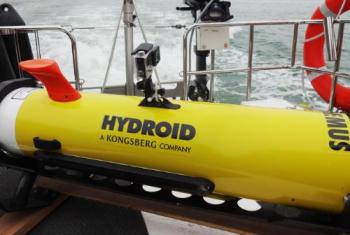Apr 23 2014
A mission off the coast of South Devon, England has surveyed two U.S. Landing Ship Tanks (LSTs) that were torpedoed and sunk during the D-Day rehearsal Exercise Tiger on April 28, 1944.
 REMUS 100 AUV on deck before launching (PRNewsFoto/Hydroid, Inc.)
REMUS 100 AUV on deck before launching (PRNewsFoto/Hydroid, Inc.)
Using state-of-the-art autonomous underwater vehicle (AUV) technology to collect data from the wreckage site, the mission has produced the first high-definition sonar images of this World War II tragedy. This was the first time in history that an AUV had surveyed the area.
The mission, which was executed by Hydroid, Inc., a subsidiary of Kongsberg Maritime and the leading manufacturer of AUVs, with additional data provided by the Royal Navy's Maritime Autonomous System Trials Team (MASTT), commemorates the 70th anniversary of Exercise Tiger. A tragic but largely unknown military operation, Exercise Tiger was a D-Day rehearsal for the invasion of Normandy's Utah Beach. The exercise took place off the southern English coast and resulted in the loss of nearly 1,000 American servicemen - more than the number of deaths at the actual invasion of Utah Beach.
The REMUS 100, a Hydroid AUV used for the mission, is designed to perform intricate oceanographic surveys over large areas. The vehicle is equipped with multiple sonar instruments that enable it to capture high-resolution imagery of objects on the sea floor. Using these instruments, Hydroid was able to secure close proximity, high-quality side scan and wide swath interferometric bathymetric multi-beam sonar images of the two LST wreck sites. The data show that both LSTs are about 50 meters below the surface and reach between six to eight meters above the seafloor. The REMUS 100 also discovered an object of interest close to the shore which may hold significance in relation to Exercise Tiger. An effort to identify this object is currently underway by the Royal Navy.
While Hydroid operated in the English Channel about 30 miles out to sea, MASTT focused on the waters just off Slapton Sands where the Exercise Tiger beach landing took place. The information collected by MASTT's REMUS 100 was an important supplement to the efforts of the Hydroid team. To commemorate the 70th anniversary of Exercise Tiger, Hydroid and the Royal Navy will be donating images obtained from this mission to the UK National Archive and local memorials.
"We hope that the data collected on this mission will shed additional light on this tragic event and help bring some closure to the families who lost their loved ones during Exercise Tiger," said Richard 'Bungy' Williams, Regional Manager, Hydroid Europe. "We are proud to use our technology to honor the memories of the servicemen who lost their lives in this tragic operation."
Source: http://www.km.kongsberg.com/